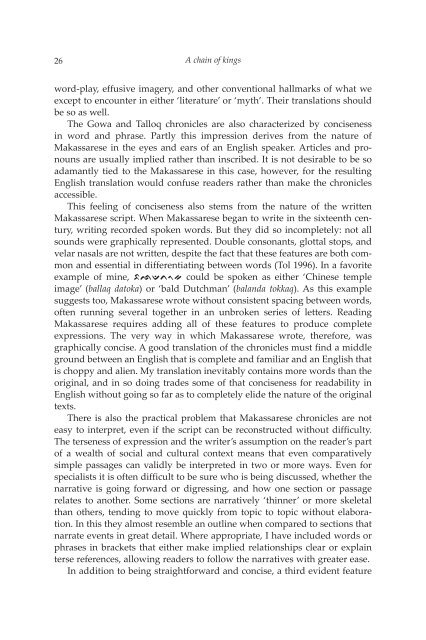A CHAIN OF KINGS - Books and Journals
A CHAIN OF KINGS - Books and Journals
A CHAIN OF KINGS - Books and Journals
Create successful ePaper yourself
Turn your PDF publications into a flip-book with our unique Google optimized e-Paper software.
26<br />
A chain of kings<br />
word-play, effusive imagery, <strong>and</strong> other conventional hallmarks of what we<br />
except to encounter in either ‘literature’ or ‘myth’. Their translations should<br />
be so as well.<br />
The Gowa <strong>and</strong> Talloq chronicles are also characterized by conciseness<br />
in word <strong>and</strong> phrase. Partly this impression derives from the nature of<br />
Makassarese in the eyes <strong>and</strong> ears of an English speaker. Articles <strong>and</strong> pronouns<br />
are usually implied rather than inscribed. It is not desirable to be so<br />
adamantly tied to the Makassarese in this case, however, for the resulting<br />
English translation would confuse readers rather than make the chronicles<br />
accessible.<br />
This feeling of conciseness also stems from the nature of the written<br />
Makassarese script. When Makassarese began to write in the sixteenth century,<br />
writing recorded spoken words. But they did so incompletely: not all<br />
sounds were graphically represented. Double consonants, glottal stops, <strong>and</strong><br />
velar nasals are not written, despite the fact that these features are both common<br />
<strong>and</strong> essential in differentiating between words (Tol 1996). In a favorite<br />
example of mine, bldtok could be spoken as either ‘Chinese temple<br />
image’ (ballaq datoka) or ‘bald Dutchman’ (bal<strong>and</strong>a tokkaq). As this example<br />
suggests too, Makassarese wrote without consistent spacing between words,<br />
often running several together in an unbroken series of letters. Reading<br />
Makassarese requires adding all of these features to produce complete<br />
expressions. The very way in which Makassarese wrote, therefore, was<br />
graphically concise. A good translation of the chronicles must find a middle<br />
ground between an English that is complete <strong>and</strong> familiar <strong>and</strong> an English that<br />
is choppy <strong>and</strong> alien. My translation inevitably contains more words than the<br />
original, <strong>and</strong> in so doing trades some of that conciseness for readability in<br />
English without going so far as to completely elide the nature of the original<br />
texts.<br />
There is also the practical problem that Makassarese chronicles are not<br />
easy to interpret, even if the script can be reconstructed without difficulty.<br />
The terseness of expression <strong>and</strong> the writer’s assumption on the reader’s part<br />
of a wealth of social <strong>and</strong> cultural context means that even comparatively<br />
simple passages can validly be interpreted in two or more ways. Even for<br />
specialists it is often difficult to be sure who is being discussed, whether the<br />
narrative is going forward or digressing, <strong>and</strong> how one section or passage<br />
relates to another. Some sections are narratively ‘thinner’ or more skeletal<br />
than others, tending to move quickly from topic to topic without elaboration.<br />
In this they almost resemble an outline when compared to sections that<br />
narrate events in great detail. Where appropriate, I have included words or<br />
phrases in brackets that either make implied relationships clear or explain<br />
terse references, allowing readers to follow the narratives with greater ease.<br />
In addition to being straightforward <strong>and</strong> concise, a third evident feature









![Am HaSefer [Volk des Buches] - Books and Journals](https://img.yumpu.com/20648352/1/174x260/am-hasefer-volk-des-buches-books-and-journals.jpg?quality=85)







